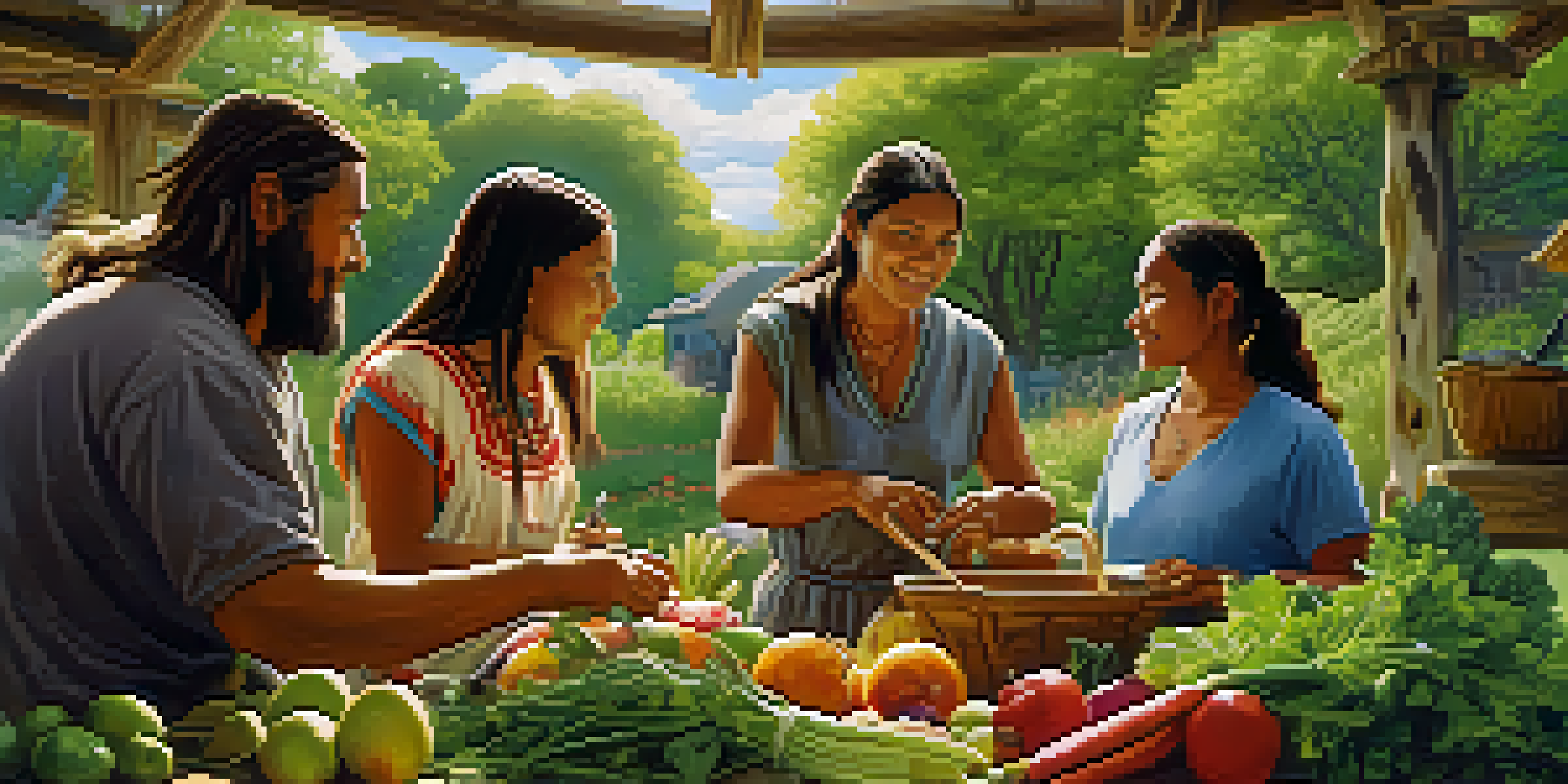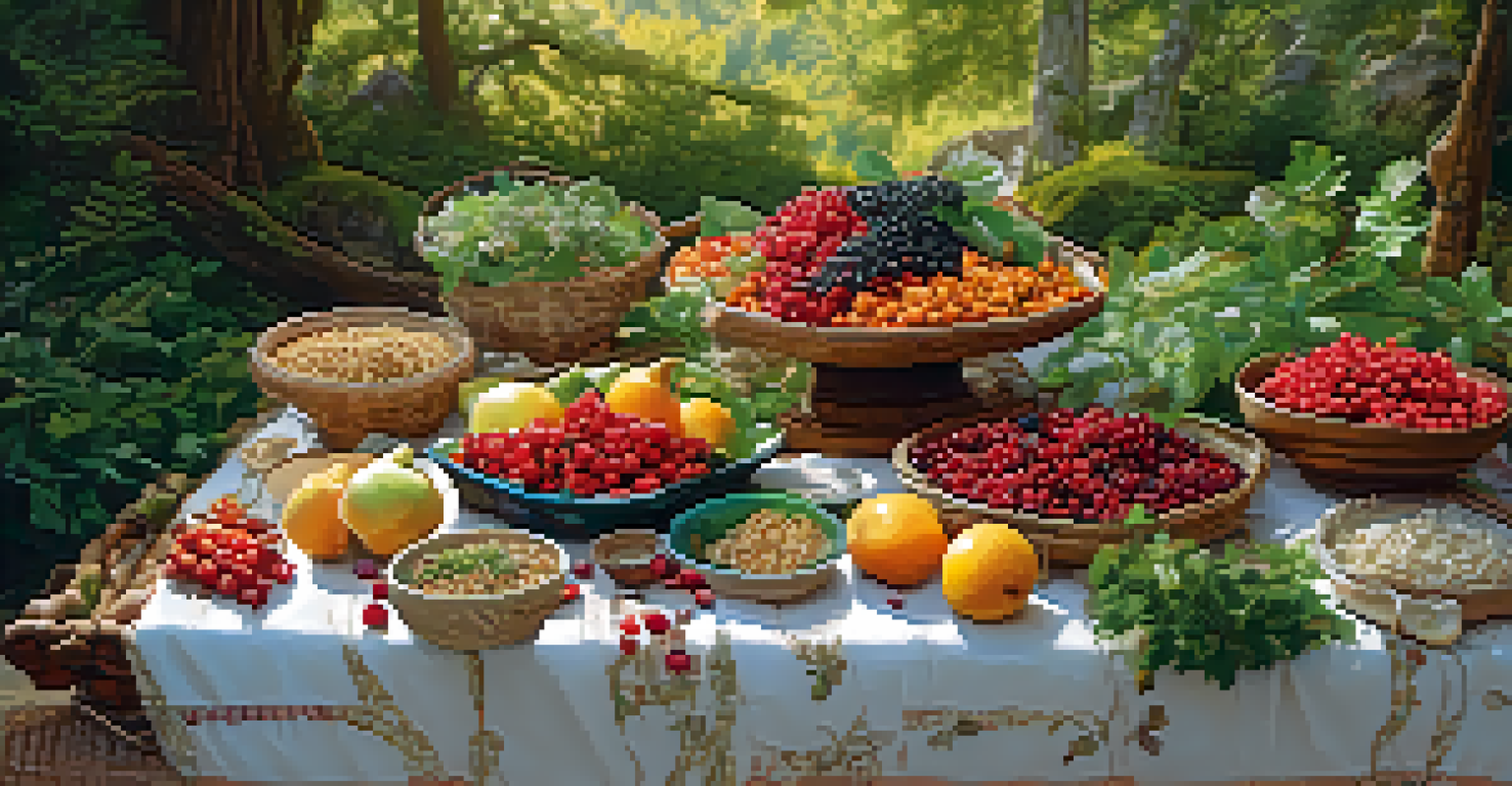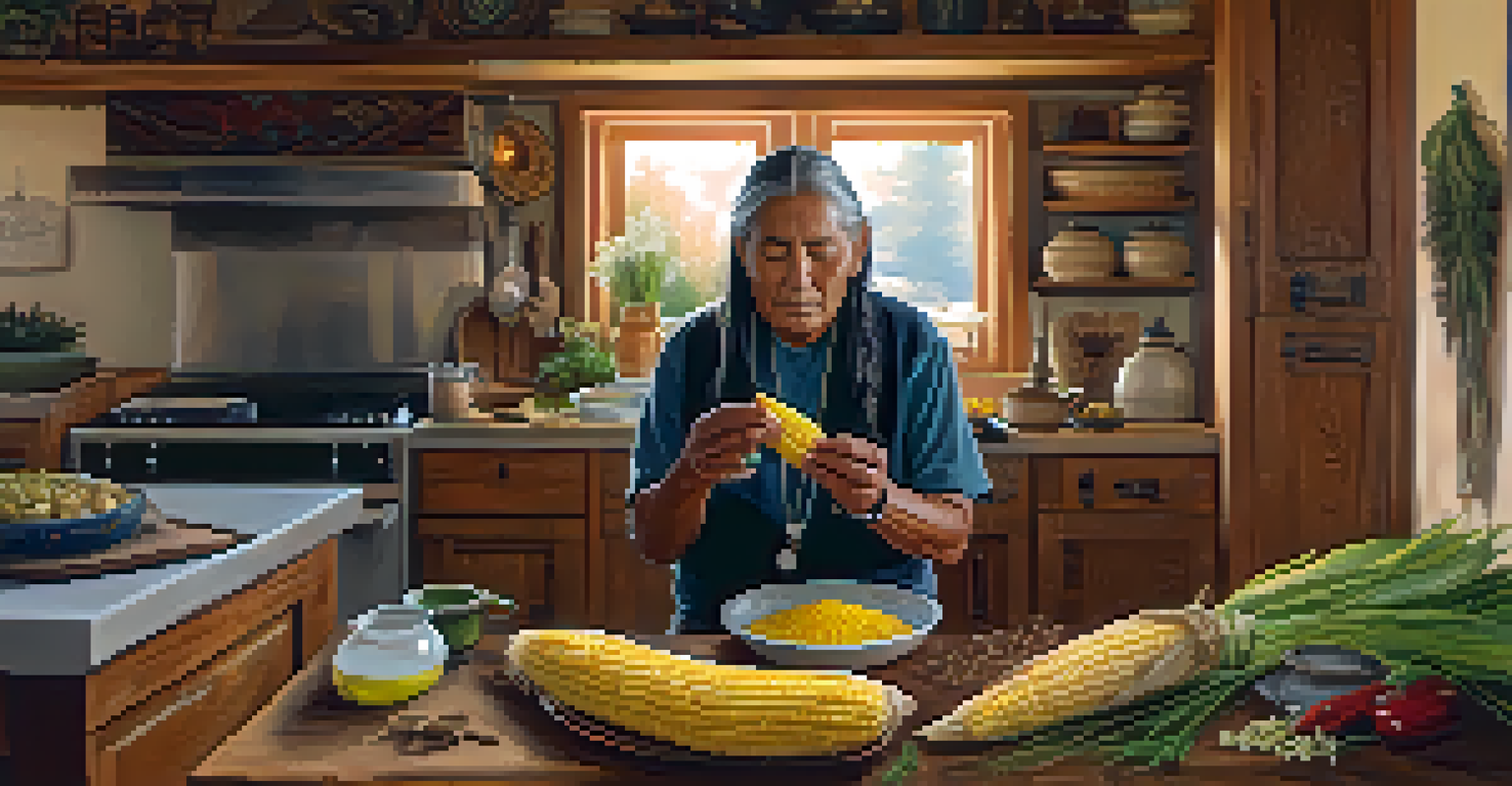Raw Food Rituals in Native American Cultural Practices

Understanding Native American Culinary Traditions
Native American culinary traditions are deeply rooted in the land and seasons, emphasizing fresh, local ingredients. Communities have historically relied on what nature provides, which often includes raw foods like fruits, vegetables, and nuts. This practice not only nourishes the body but also fosters a spiritual connection to the earth. By using ingredients in their raw form, these cultures honor the original state of the food, celebrating its natural flavors and nutrients.
Food is our common ground, a universal experience.
Culinary practices among Native Americans vary widely across regions, reflecting the diverse ecosystems and resources available. For instance, tribes in the Pacific Northwest might focus on salmon and berries, while those in the Southwest may utilize cacti and corn. Each tribe's unique relationship with their environment influences their approach to food preparation and consumption, reinforcing the idea that food is more than just sustenance—it's a reflection of identity.
This strong connection to culinary traditions encourages sustainable practices that respect the environment. By valuing raw foods, Native American cultures promote a lifestyle that honors both health and the planet. This deeply ingrained philosophy teaches us that what we eat can profoundly impact not just our bodies, but also our communities and ecosystems.
The Role of Rituals in Food Preparation
Rituals play a significant role in Native American food preparation, often intertwining with spiritual beliefs and cultural practices. Before preparing food, many tribes engage in ceremonies that express gratitude to the earth and its bounty. These rituals can include prayers, songs, or offerings, signaling a deep respect for the natural world and acknowledging the interconnectedness of life.

In many tribes, specific raw foods are associated with certain rituals or occasions, enhancing their cultural significance. For example, the preparation of corn can be linked to various ceremonies celebrating the harvest, symbolizing abundance and sustenance. Such practices reinforce community bonds, as families and friends come together to participate in these meaningful experiences.
Culinary Traditions Reflect Identity
Native American culinary practices are deeply tied to the land and seasons, showcasing a unique relationship with local ingredients that reflect cultural identity.
Through these rituals, food becomes a medium for storytelling and heritage, passed down through generations. Each act of preparation is a reminder of the teachings and traditions that shape a community's identity. This rich tapestry of rituals highlights how raw food practices are not merely about nourishment, but also about preserving history and culture.
Healing Properties of Raw Foods
Raw foods are often celebrated for their health benefits, which are especially valued in Native American cultures. Many tribes believe that consuming foods in their natural state preserves their healing properties, providing essential nutrients that can restore balance to the body. This belief is rooted in a holistic understanding of health, where physical, spiritual, and emotional well-being are interconnected.
The act of eating is a deeply communal experience that connects us to our ancestors and the earth.
For example, indigenous herbs and plants are commonly used in raw forms for their medicinal qualities, often incorporated into traditional remedies. Foods like wild berries, roots, and nuts not only serve as nourishment but also play a role in maintaining health and preventing illness. This practice reflects a deep understanding of the natural world and its resources, emphasizing the importance of living in harmony with nature.
Moreover, the emphasis on raw foods fosters a lifestyle that prioritizes clean eating and sustainability. By choosing to consume fresh, unprocessed ingredients, Native Americans model a way of life that promotes health and wellness. This connection between food and healing underscores the broader philosophy of respecting the body as a sacred vessel.
Seasonal Eating and Its Cultural Significance
Seasonal eating is a prominent aspect of Native American food practices, emphasizing the importance of consuming foods at their peak freshness. By aligning their diets with the natural cycles of the environment, tribes honor the rhythms of nature and promote biodiversity in their food sources. This approach not only enhances the flavor and nutritional value of the food but also supports local ecosystems.
For many Native American communities, certain raw foods are harvested during specific seasons, marking important cultural events and celebrations. For instance, the gathering of wild berries or the first corn harvest often coincides with communal festivities, reinforcing the connection between food, culture, and community. These seasonal practices foster a sense of belonging and continuity, linking individuals to their ancestors and the land.
Rituals Enhance Food Preparation
Rituals in food preparation emphasize gratitude and community bonding, transforming meals into meaningful cultural experiences.
Additionally, this focus on seasonal eating can inspire modern approaches to sustainable living. By understanding the benefits of consuming locally sourced, seasonal foods, we can adopt practices that not only promote our health but also support the environment. Learning from Native American traditions, we can appreciate the bounty of each season and the role it plays in our overall well-being.
Raw Food and Spiritual Connection
For many Native American tribes, raw foods hold a spiritual significance that transcends mere nourishment. The act of preparing and consuming food is often seen as a sacred ritual, fostering a deep connection to the land and its resources. This relationship encourages gratitude and reverence for the earth, reminding individuals of their role within the larger ecosystem.
Certain raw foods are imbued with symbolic meanings, representing various aspects of life and spirituality. For example, the corn plant is often viewed as a source of life and sustenance, with significant roles in creation myths and rituals. By consuming raw corn, individuals not only nourish their bodies but also partake in a tradition that honors their ancestors and the natural world.
This spiritual connection extends beyond the act of eating; it encompasses the entire process of food cultivation and preparation. By engaging in these practices, Native Americans reinforce their relationship with the earth and acknowledge the importance of living in harmony with nature. This holistic perspective on food encourages a mindful approach to consumption and deepens our understanding of its role in our lives.
Community and Sharing in Raw Food Practices
In Native American cultures, food is often viewed as a communal experience, with raw food practices fostering connections among individuals and families. Sharing meals is a way to reinforce social bonds, convey love, and strengthen community ties. This emphasis on togetherness is reflected in the preparation and enjoyment of raw foods, as families gather to create and share nourishing dishes.
Potlucks and communal feasts are common, where everyone contributes raw dishes made from fresh ingredients. These gatherings provide an opportunity for storytelling, cultural exchange, and the passing down of traditions. The act of sharing food becomes a celebration of life, culture, and community, allowing individuals to feel connected to one another and their heritage.
Health Benefits of Raw Foods
Raw foods are valued for their health benefits, promoting a holistic approach to well-being that connects physical, spiritual, and environmental health.
Moreover, these communal practices highlight the importance of collaboration and mutual support within Native American societies. By coming together to prepare and enjoy raw foods, individuals are reminded of their interconnectedness and the shared responsibility of caring for one another and the environment. This sense of community fosters resilience and strengthens cultural identity.
Modern Adaptations of Traditional Raw Food Practices
As contemporary society evolves, many Native American communities are finding ways to adapt traditional raw food practices to modern lifestyles. This includes incorporating raw foods into everyday diets while still honoring ancestral methods and values. By blending old and new approaches, these communities can maintain their cultural heritage while embracing the benefits of modern nutrition.
For instance, some tribes are reviving traditional farming techniques that prioritize organic and sustainable practices, allowing them to cultivate raw foods that are both healthy and culturally significant. This revival not only supports community health but also reinforces the importance of agricultural knowledge passed down through generations. The fusion of traditional wisdom with modern techniques creates a dynamic approach to food that respects the past while looking toward the future.

Additionally, the popularity of raw food diets in mainstream culture has led to greater awareness and appreciation for these practices. As more people explore plant-based and raw food options, they can learn from Native American traditions, adopting principles of sustainability and health. This growing interest can facilitate cultural exchange and foster greater respect for indigenous practices and their significance.